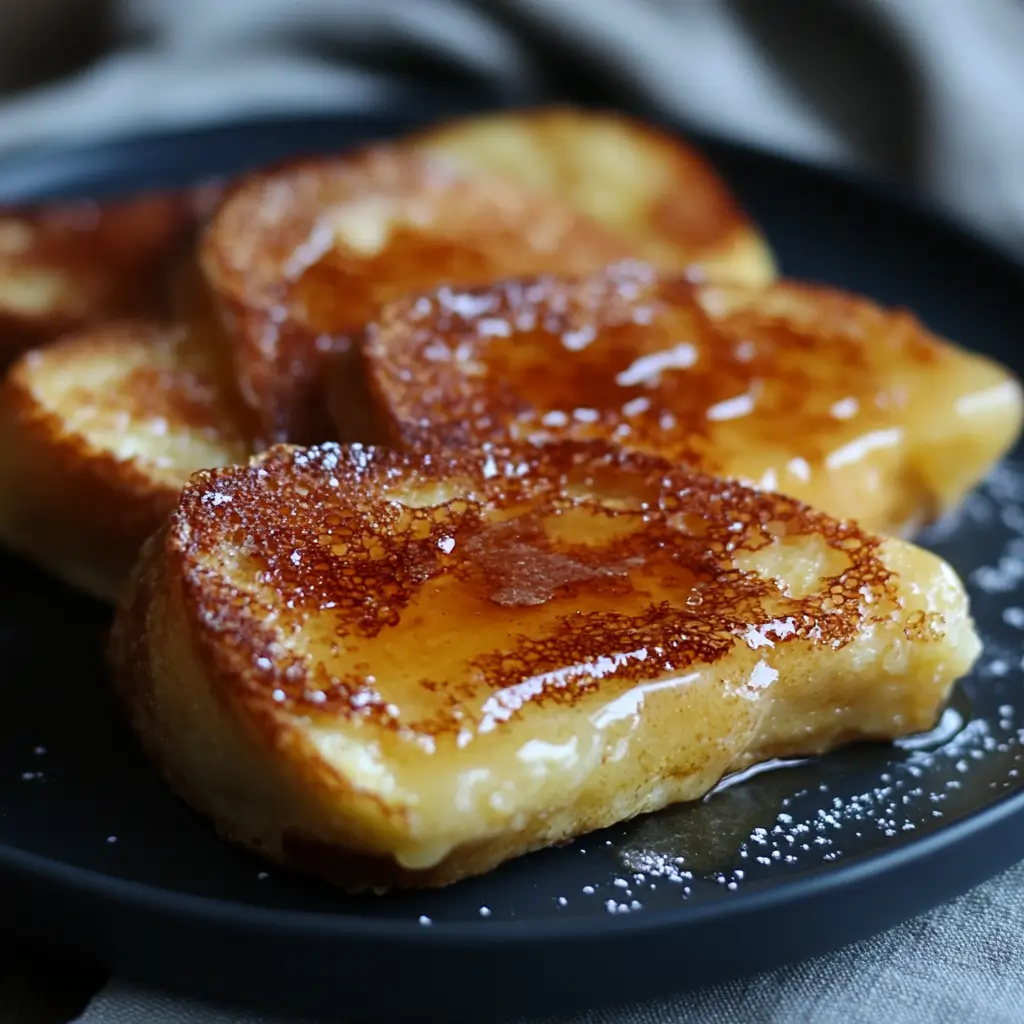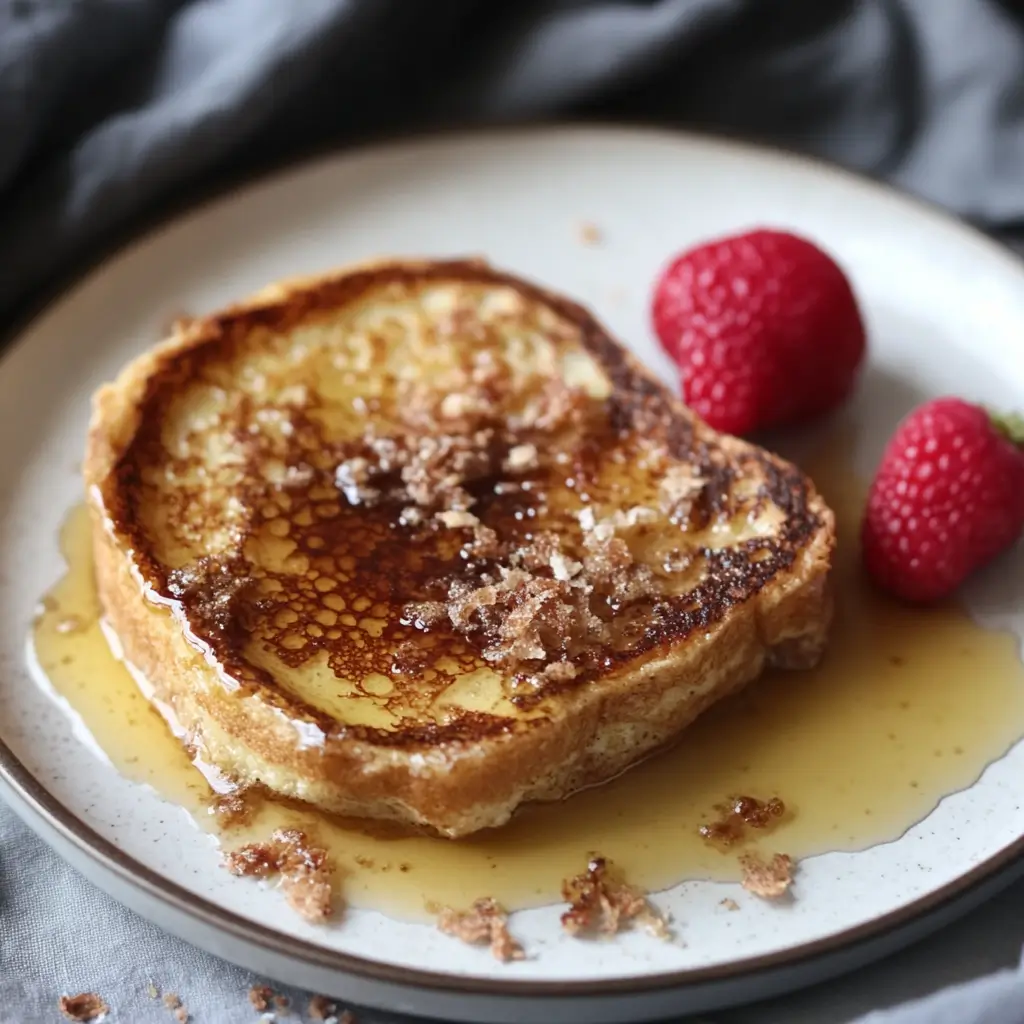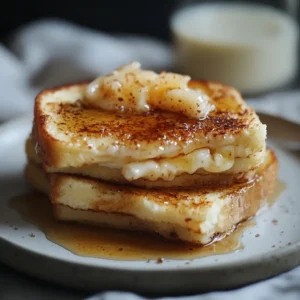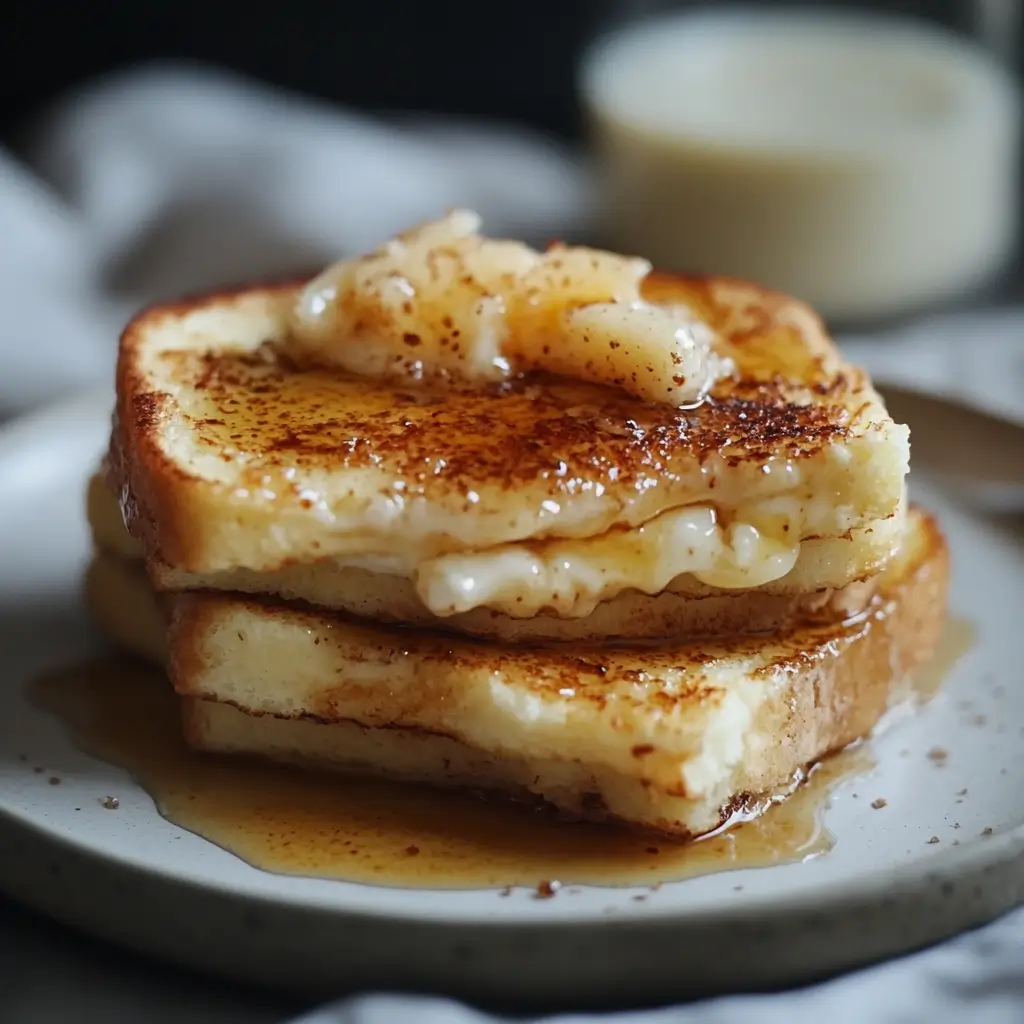Breakfast is often considered the most important meal of the day, but it doesn’t have to be boring or rushed. With recipes like Overnight Crème Brûlée French Toast , you can elevate your morning routine into an indulgent experience that feels more like dessert than breakfast. This decadent dish combines the comforting flavors of classic French toast with the caramelized crunch of crème brûlée, creating a culinary masterpiece that’s as easy to prepare as it is delicious.
In this guide, we’ll walk you through every step of making Overnight Crème Brûlée French Toast, from selecting the right ingredients to perfecting the broiling technique. Whether you’re hosting a weekend brunch or simply looking to treat yourself, this recipe will leave you—and your guests—speechless. Let’s dive in!
Understanding the Ingredients
The foundation of any great recipe lies in its ingredients. For Overnight Crème Brûlée French Toast, choosing high-quality components ensures the best possible outcome. Here’s everything you need to know about each key ingredient:
Key Base Ingredients
Brioche Bread (or Challah)
Brioche bread is the star of this recipe because of its rich buttery flavor and soft texture. Its slightly sweet taste complements the custard mixture perfectly. If brioche isn’t available, challah bread makes an excellent substitute due to its similar characteristics. Avoid using stale bread, as overly dry slices may absorb too much liquid, resulting in soggy French toast.
Eggs
Eggs are crucial for binding the custard mixture together while adding protein and structure to the final dish. Use large eggs for consistency and ensure they’re fresh for optimal flavor. The proteins in the eggs help create a golden crust when cooked.
Milk
Whole milk is ideal for this recipe because it provides richness and creaminess. However, if you prefer a lighter version, you can use reduced-fat milk or even almond milk for a dairy-free option. Keep in mind that non-dairy alternatives might alter the texture slightly.
Flavor Enhancers
Vanilla Extract
Pure vanilla extract adds depth and warmth to the custard mixture. Opt for pure extract over artificial flavoring for a more authentic taste. You can also experiment with vanilla beans by scraping the seeds directly into the mixture for an extra burst of aroma.
Cinnamon Sugar
This classic spice blend brings warmth and sweetness to the dish. Mix ground cinnamon with granulated sugar and sprinkle it generously over the soaked bread before cooking. Adjust the ratio according to your preference; some people enjoy a stronger cinnamon kick, while others prefer a subtler note.
Heavy Cream
Adding heavy cream to the custard mixture enhances its richness and creates a velvety texture. While optional, it elevates the overall quality of the French toast significantly. If you’d rather skip it, whole milk alone will still yield good results.
Sweetening Agents
Brown Sugar
Brown sugar plays a dual role in this recipe—it sweetens the custard mixture and forms the caramelized top layer after broiling. Its molasses content adds complexity to the flavor profile. Be sure to spread the brown sugar evenly across the surface of the cooked French toast for uniform caramelization.
Granulated Sugar
For the signature crème brûlée finish, granulated sugar is essential. Sprinkle a thin, even layer over the brown sugar before using a torch or broiler to melt it into a crispy, golden crust. Fine-grained sugar works best for achieving a smooth caramelized layer.
Optional Add-ins
Whipped Cream
Serving your French toast with a dollop of whipped cream transforms it into an elegant dessert-inspired dish. You can make homemade whipped cream by beating heavy cream with powdered sugar and vanilla extract until stiff peaks form. Alternatively, store-bought whipped cream is convenient and just as tasty.
Fresh Berries
Top your French toast with fresh berries like strawberries, blueberries, or raspberries for a pop of color and natural sweetness. Not only do they enhance the presentation, but they also balance out the richness of the dish with their juicy freshness.
Preparing the Custard Mixture

A well-prepared custard mixture is the backbone of successful French toast. Follow these steps carefully to achieve the perfect consistency and flavor.
Mixing the Base
To begin, crack the required number of eggs into a mixing bowl. Whisk them thoroughly to break down the yolks and whites. Gradually add milk (or cream), vanilla extract, and cinnamon sugar while continuing to whisk. The goal is to create a smooth, lump-free liquid that coats the back of a spoon. Taste the mixture at this stage to ensure it meets your desired level of sweetness and spiciness.
Tip: If you want to infuse additional flavors, steep vanilla pods or spices like nutmeg in the milk before incorporating it into the egg mixture.
Soaking the Bread
Once the custard mixture is ready, slice your chosen bread into thick pieces (about 1 inch thick). Dip each slice into the mixture, allowing it to soak for approximately 30 seconds on each side. Don’t rush this process—if the bread isn’t saturated enough, it won’t hold up during cooking. Conversely, avoid oversoaking, which could cause the bread to fall apart.
If preparing overnight French toast, arrange the soaked slices in a greased baking dish, overlapping them slightly if necessary. Pour any remaining custard over the top to ensure all surfaces are coated.
Layering the Dish
For an extra-rich experience, consider layering additional ingredients between the bread slices. Chopped nuts, chocolate chips, or sliced bananas can add texture and flavor dimensions. Simply sprinkle these additions onto each layer before stacking the next slice on top. Cover the dish tightly with plastic wrap or aluminum foil and refrigerate overnight.
Refrigerating Overnight
Refrigeration allows the bread to absorb the custard mixture fully, resulting in a moist yet firm texture. Leave the dish in the fridge for at least 8 hours or up to 24 hours. This step not only simplifies morning preparation but also intensifies the flavors as the ingredients meld together.
Important Note: Ensure the dish is covered securely to prevent odors from other foods in the refrigerator from affecting the taste.
“Here are some additional resources to help you perfect your Crème Brûlée French Toast:
- AllRecipes Crème Brûlée French Toast – A classic and reliable recipe worth trying.”
Cooking the French Toast

Now comes the fun part—cooking your masterpiece! Proper technique ensures your French toast turns out golden brown and perfectly caramelized.
Preheating Your Pan
Choosing the right pan and properly preheating it is crucial for achieving perfectly cooked French toast. The type of pan you use can significantly impact the outcome, so let’s break down the best options and techniques:
Selecting the Right Pan
For this recipe, opt for a heavy-bottomed skillet or griddle that distributes heat evenly. Non-stick pans are ideal because they prevent sticking, allowing the French toast to develop a golden crust without tearing. If you don’t have a non-stick pan, you can use a well-seasoned cast-iron skillet, which also provides excellent heat retention. Avoid thin or flimsy pans, as they may cause hot spots that lead to uneven cooking.
Why Medium-Low Heat Works Best
Cooking French toast on medium-low heat might seem counterintuitive if you’re used to high-heat cooking methods, but it’s essential for several reasons:
- Even Browning: Lower heat allows the exterior of the bread to brown gradually, preventing burning while giving the inside time to cook thoroughly.
- Moisture Retention: High heat can dry out the bread quickly, leaving it crispy on the outside but undercooked or rubbery on the inside. Medium-low heat ensures the custard-soaked bread retains its moisture.
- Controlled Cooking: A lower temperature gives you better control over the cooking process, reducing the risk of overcooking or burning.
Preparing the Pan
Before adding the bread, ensure the pan is preheated for at least 2–3 minutes. Add butter or oil (or a combination) to coat the surface generously. Butter adds richness and flavor, while oil helps prevent sticking and promotes browning. For an extra layer of flavor, consider using clarified butter, which has a higher smoke point and imparts a nutty aroma.
Pro Tip: To test if the pan is ready, sprinkle a few drops of water onto the surface. If the water sizzles and evaporates immediately, the pan is at the perfect temperature.
Cooking Each Slice
Once your pan is preheated and coated with butter or oil, it’s time to start cooking each slice of French toast. This step requires patience and attention to detail to achieve the desired texture and appearance.
Placing the Slices
Carefully place one soaked slice of bread onto the preheated pan. Allow it to sit undisturbed for 3–5 minutes. Resist the temptation to press down on the bread with a spatula, as this can squeeze out the custard mixture and result in dry toast. Instead, let the natural weight of the bread absorb the heat and develop a golden crust.
Flipping Technique
When the underside of the bread turns deep golden brown, gently flip it using a wide spatula. Ensure the spatula slides smoothly under the slice to avoid breaking it apart. Cook the second side for another 3–5 minutes, monitoring closely to achieve an even color. The internal texture should be soft and custardy, with no raw egg taste.
Managing Multiple Slices
If cooking multiple slices at once, leave enough space between them to allow for proper airflow and even browning. Overcrowding the pan can cause steaming instead of searing, leading to soggy results. If necessary, cook in batches to maintain quality.
Adjusting Cooking Time
The exact cooking time may vary depending on the thickness of your bread slices and the heat level of your pan. Thicker slices will require longer cooking times, so adjust accordingly. Use a visual cue—the toast should be deeply golden brown with a slight crispness on both sides.
Important Note: If the first slice doesn’t turn out exactly as expected, don’t worry! Adjust the heat slightly for subsequent slices to refine your technique.
Broiling for a Crème Brûlée Finish
The crème brûlée finish is what sets this French toast apart from traditional recipes. Achieving a perfectly caramelized sugar crust requires precision and care. Here’s how to do it step by step:
Spreading the Sugar
After cooking both sides of the French toast, transfer the slices to a baking sheet lined with parchment paper. Using a spoon or small offset spatula, spread a generous layer of brown sugar evenly over the tops of the slices. Brown sugar adds depth and moisture to the caramelization process. Then, sprinkle a thin, even layer of granulated sugar on top of the brown sugar. Fine-grained sugar works best because it melts smoothly and creates a uniform crust.
Using the Broiler
Place the baking sheet under the broiler in your oven. Set the broiler to high and position the rack about 6 inches away from the heating element. Watch the sugar carefully, as it can go from caramelized to burnt very quickly. After 1–2 minutes, the sugar should begin to bubble and turn amber in color. Remove the tray immediately once the desired level of caramelization is achieved.
Using a Crème Brûlée Torch
If you prefer more control, a handheld crème brûlée torch is an excellent alternative to the broiler. Hold the torch about 2 inches above the sugar and move it back and forth in a sweeping motion. Focus on melting the sugar evenly until it forms a crispy, golden crust. This method allows you to caramelize each slice individually, ensuring consistent results.
Troubleshooting Common Issues
- Sugar Not Melting: If the sugar isn’t melting properly, try increasing the heat slightly or spreading the sugar more thinly.
- Burnt Sugar: If the sugar burns before caramelizing, reduce the heat or distance from the heat source. Work quickly and monitor the process closely.
Pro Tip: Let the caramelized sugar cool for a minute before serving to allow it to harden slightly, creating that satisfying crunch.
Serving Suggestions
Presentation and accompaniments play a vital role in elevating your Overnight Crème Brûlée French Toast from a simple breakfast dish to a gourmet experience. Here are some ideas to enhance its appeal:
Classic Toppings
Start with timeless favorites like whipped cream and powdered sugar. Whipped cream adds lightness and contrast to the rich flavors of the French toast, while powdered sugar provides a delicate dusting that enhances sweetness.
Fresh Fruit
Garnish your French toast with fresh berries such as strawberries, blueberries, or raspberries. These fruits not only add vibrant colors but also balance the richness with their natural tartness and juiciness. Sliced bananas or diced peaches are other great options for a tropical twist.
Syrups and Sauces
Drizzle maple syrup or honey over the top for an extra touch of sweetness. For something more indulgent, consider warm caramel sauce, chocolate ganache, or a berry compote. These sauces complement the caramelized sugar crust beautifully.
Nutty Accents
Sprinkle chopped nuts like almonds, pecans, or walnuts over the French toast for added texture and crunch. Toasting the nuts beforehand brings out their natural oils and enhances their flavor.
Creative Ideas
For a festive touch, dust the plate with cocoa powder or cinnamon for a decorative flair. Alternatively, serve the French toast alongside a scoop of vanilla ice cream for a dessert-inspired breakfast treat.
Presentation Tips
Arrange the French toast neatly on the plate, stacking slices if desired. Place toppings strategically to create an inviting visual presentation. Garnish with mint leaves or edible flowers for an elegant finishing touch.
Final Thought: Remember, the beauty of this dish lies in its versatility. Feel free to experiment with different combinations of toppings and sauces to find your perfect pairing!
Make-ahead fans will love these Blueberry Cinnamon Rolls too!
Variations and Customizations

One of the joys of cooking is experimenting with different flavors and techniques. Here are some ideas to personalize your Overnight Crème Brûlée French Toast.
Different Types of Bread
While brioche and challah are traditional choices, feel free to explore other options. Sourdough adds tanginess, Texas toast offers thickness, and even baguettes can work if sliced thinly. Just adjust soaking times accordingly to accommodate varying densities.
Flavor Additions
Infuse your custard mixture with unique flavors by adding liqueurs such as rum, brandy, or Grand Marnier. Alternatively, incorporate spices like cardamom, ginger, or cloves for a holiday-inspired twist. These additions deepen the complexity of the dish without overpowering the primary flavors.
Nutritional Tweaks
For those seeking healthier alternatives, swap whole milk with almond, oat, or coconut milk. Replace regular eggs with flaxseed “eggs” or aquafaba for vegan versions. Additionally, reduce sugar content or opt for natural sweeteners like honey or maple syrup.
Seasonal Variations
Tailor your recipe to the season. In autumn, add pumpkin puree and pumpkin pie spice to evoke cozy vibes. During summer, incorporate citrus zest or fresh herbs like mint for refreshing notes. These small changes keep your French toast exciting year-round.
Tips for Success
Mastering Overnight Crème Brûlée French Toast requires attention to detail and practice. Here are some expert tips to guarantee success every time.
Common Mistakes to Avoid
Over-soaking the bread is a frequent error that leads to mushy results. Always monitor soaking times closely. Similarly, failing to caramelize the sugar properly can detract from the dish’s visual appeal and signature crunch. Practice patience and precision when applying heat to the sugar.
Storage and Reheating
Store leftover French toast in an airtight container in the refrigerator for up to three days. To reheat, place slices in a toaster oven or conventional oven set to 350°F (175°C) until warmed through. Microwaving tends to soften the crust, so it’s best avoided unless absolutely necessary.
Time-Saving Tricks
Prepare multiple batches ahead of time and freeze individual portions for quick breakfasts. Thaw frozen slices overnight in the refrigerator before reheating. Having pre-made French toast on hand eliminates last-minute stress.
Tools You’ll Need
Invest in quality kitchen tools to streamline the process. A sturdy whisk ensures thorough mixing of the custard, while a reliable skillet guarantees even cooking. A crème brûlée torch is indispensable for achieving that perfect caramelized finish. Brands like KitchenAid, All-Clad, and Cuisinart offer durable, efficient products worth considering.
Conclusion
Overnight Crème Brûlée French Toast represents the pinnacle of breakfast luxury. By following this comprehensive guide, you’ll master the art of crafting this decadent dish with confidence. From selecting premium ingredients to executing flawless techniques, every step contributes to the final product’s success. So gather your materials, roll up your sleeves, and get ready to indulge in a breakfast experience unlike any other. Bon appétit!

Overnight Crème Brûlée French Toast
Equipment
- Mixing bowl
- Whisk
- 9×13 inch baking dish (or similar size)
- Measuring cups and spoons
- Chef’s torch (for caramelizing sugar, optional)
- Spatula
- Knife (for slicing bread)
Ingredients
- For the French Toast:
- 1 loaf French bread or brioche cut into 1-inch thick slices
- 6 large eggs
- 2 cups heavy cream or half-and-half for a lighter option
- 1 cup whole milk
- 1/2 cup granulated sugar plus extra for topping
- 1 tablespoon vanilla extract
- 1 teaspoon ground cinnamon
- Pinch of salt
- For the Caramelized Sugar Topping:
- 1/4 cup granulated sugar for sprinkling on top before serving
Instructions
- Prepare the Custard Mixture : In a large mixing bowl, whisk together the eggs, heavy cream, milk, sugar, vanilla extract, cinnamon, and salt until smooth and well combined.
- Assemble the French Toast :
- Arrange the bread slices in a single layer in a greased 9×13-inch baking dish. If needed, cut some slices to fit the dish snugly.
- Pour the custard mixture evenly over the bread, ensuring all slices are soaked. Press down gently with a spatula to help the bread absorb the liquid.
- Cover the dish with plastic wrap or foil and refrigerate overnight (or for at least 4–6 hours).
- Preheat the Oven : The next day, preheat your oven to 350°F (175°C). Remove the dish from the refrigerator and let it sit at room temperature for 15–20 minutes.
- Bake the French Toast : Bake the dish uncovered for 40–45 minutes, or until the custard is set and the top is golden brown.
- Caramelize the Sugar :
- Once baked, sprinkle a thin, even layer of granulated sugar over the top of the French toast.
- Use a chef’s torch to caramelize the sugar until it forms a golden-brown crust. Alternatively, place the dish under the broiler for 1–2 minutes, watching closely to avoid burning.
- Serve : Slice into portions and serve warm. Optionally, garnish with fresh berries or a dusting of powdered sugar.
Notes
If you don’t have a chef’s torch, the broiler method works well but requires careful monitoring to prevent burning.
Substitute heavy cream with coconut milk for a dairy-free version.
Store leftovers in an airtight container in the refrigerator for up to 2 days. Reheat in the oven or microwave before serving.

